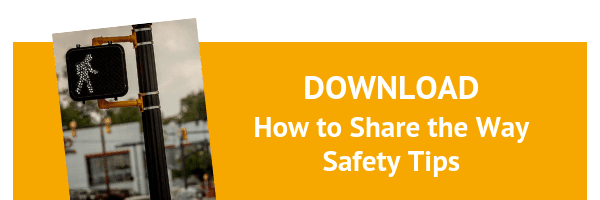Madrid Gets Friendlier for People Walking and Biking
Around the world and here at home, cities are enacting policies to make their streets friendlier for people walking and biking. Today, we're looking at changes happening in Madrid and a few happening in your backyard.
Madrid is one of the latest European cities to make more places in a city friendly for people walking and biking. In November 2018, Madrid implemented a “Sustainable Mobility Ordinance” with the objectives to improve the coexistence of multiple modes of transportation; improve air quality; promote public transit, walking, and biking; balance road uses with parking; and update regulations.
Changes to Madrid Central
The biggest change is the creation of Madrid Central, an area encompassing most of the downtown district which will be open only to people walking, biking, and taking transit (with a few exceptions). This area is well-served by transit, with 60 bus lines, six subway lines, eight underground train lines, and 57 BiciMad bikeshare stations, which makes it a great place to prioritize walking and biking. The only vehicles that will be permitted in Madrid Central are those owned by residents of the area, those used for people with reduced mobility, taxis, delivery vans, electric vehicles, and buses.
Speed Reduction
Another major change is speed reduction with Madrid creating “Zonas 30” and “Calles 20” which will have lower speed limits. These changes are significant for the movement of people walking and biking—particularly the Calles 20 where people walking will have priority. All one-way streets and single-lane two-way streets will have a speed limit of 30 km/hr, and shared neighborhood streets will have a speed limit of 20 km/hr. Reducing vehicle speed has been shown to not only reduce the chance of a crash, but to minimize the harm in crashes that do occur. The ordinance also includes other new rules, including allowing people on bikes to turn right on a red light and to travel against traffic on the 20 km/hr streets.
International Trends for Street Design
Madrid’s steps are part of an international trend toward safer street design, policies, and infrastructure. Madrid follows other European cities, such as Oslo, Copenhagen, Brussels, Munich, Paris, and London in making portions of their cities priority zones for people walking.
In the United States, initiatives such as Vision Zero call for measures like reducing speed and prioritizing walking and biking. Only a handful of US cities, such as New York City, have prioritized pedestrian zones and restricted vehicle access like Madrid.
Arlington Pushes for Safer Streets
Sustainable or active modes of transportation, including walking, biking, and rolling, are central to Arlington County’s Smart Growth vision. Arlington has its own initiatives to improve the coexistence of multiple modes of transportation.
- Arlington’s Department of Environmental Services implements quick and low-cost street redesigns and analyzes crash data to identify potential areas for improvement and recently won an award for their innovative protected bike lane design.
- Arlington Public Schools partners with several County organizations on the Safe Routes to School program teaches kids and parents the benefits being active and encourages walking, biking, and rolling.
- Multiple regional partners work together on expanding and enhancing our trails network, such as the Custis Trail project in Rosslyn.
Share the Way
As cities like Arlington, Madrid, New York, and Oslo continue developing streets and trails to improve the coexistence of multiple modes of transportation, every person has a role to play in being predictable, alert, lawful, and friendly no matter how we’re moving about places.
Before venturing out on two wheels or two feet, download our sharing the way safety tips for trails and sidewalks.

Sam Kittner/Kittner.com










Comments are closed here.
To prevent spam, comments will be approved before appearing on the post. If you have a comment or question, but do not want it to be published, please email WalkArlington.